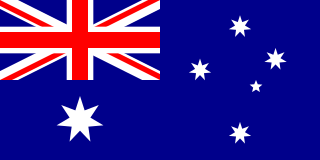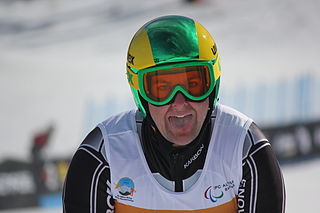| Personal information | ||||||||||||||||||||||||||||||
|---|---|---|---|---|---|---|---|---|---|---|---|---|---|---|---|---|---|---|---|---|---|---|---|---|---|---|---|---|---|---|
| Nationality | ||||||||||||||||||||||||||||||
| Born | 1968 (age 55–56) | |||||||||||||||||||||||||||||
Medal record
| ||||||||||||||||||||||||||||||
Patrick Cooper (born 1968) is a winter Paralympian from New Zealand who competed in the Paralympic Winter Games in 1988, 1992 and 1994 in the para alpine skiing.
| Personal information | ||||||||||||||||||||||||||||||
|---|---|---|---|---|---|---|---|---|---|---|---|---|---|---|---|---|---|---|---|---|---|---|---|---|---|---|---|---|---|---|
| Nationality | ||||||||||||||||||||||||||||||
| Born | 1968 (age 55–56) | |||||||||||||||||||||||||||||
Medal record
| ||||||||||||||||||||||||||||||
Patrick Cooper (born 1968) is a winter Paralympian from New Zealand who competed in the Paralympic Winter Games in 1988, 1992 and 1994 in the para alpine skiing.
Cooper made his first appearance at the Winter Games in Innsbruck 1988. He competed in the Men's Slalom LW4 event where he won a silver medal. [1]
In his second Winter Game, the Albertville 1992 Paralympic Winter Games, he won 2 gold medals for New Zealand from the Men's Slalom LW4 and Super-G LW4 event. [1]
In Lillehammer 1994 Paralympic Winter Games, Cooper managed to grab 3 medals for his country, gold in Men's Slalom LW4 and Men's Super-G LW4 and a bronze medal in the Men's Giant Slalom LW4 event. [2]

Australia has competed in every Winter Paralympics. In 1976, the first Games, Australia's sole competitor was Ron Finneran, but he was not an official entrant. In 1980, Kyrra Grunnsund and Peter Rickards became the first official competitors, in alpine and cross-country skiing. The number of Australian athletes increased to three, five, five and six at the next four games, respectively, and all of the athletes were alpine skiers. The participation decreased to four in 1998 and climbed back up to six in 2002. Australia won its first Winter Paralympic medals in 1992, and has medalled at every games since then. All of the medals have been won in alpine skiing.

Michael John Milton, OAM is an Australian Paralympic skier, Paralympic cyclist and paratriathlete with one leg. With 6 gold, 3 silver and 2 bronze medals he is the most successful Australian Paralympic athlete in the Winter Games.

Alpine skiing has been contested at every Winter Olympics since 1936, when a combined event was held in Garmisch-Partenkirchen, Germany.

The alpine skiing competition of the Vancouver 2010 Paralympics will be held at Whistler, British Columbia. The events were due to be held between 13 March, and 21 March 2010. Events scheduled for 13 March, however, were postponed due to weather conditions – specifically, low visibility. The snowboard cross event was a demonstration sport until 2014.

Australia sent a delegation to compete at the 1988 Winter Paralympics in Innsbruck, Austria, which was held between 17–24 January 1988. This marked the nation's fourth appearance at the Winter Paralympics. The delegation sent a group of five alpine skiers as they wouldn't get a medal in these games.

Australia competed at the 1992 Winter Paralympics in Tignes and Albertville in France. They were the first winter Paralympics to be celebrated concurrently with the Olympic Games. The official logo of the Games was designed by Jean-Michel Folon. It depicts a bird with broken wings, soaring high across the peak of a mountain. This was used to reflect the sporting abilities of the athletes at the Games. The official mascot, Alpy, designed by Vincent Thiebaut, represented the summit of the Grande Motte mountain in Tignes. Alpy was shown on a mono-ski to demonstrate its athleticism and the colours of white, green and blue were used to represent purity/snow, hope/nature and discipline/the lake. The 1992 Games were where Australia won their first winter medals at the Paralympics. Michael Milton won Australia's first gold with a win in the men's slalom LW2. Milton also won a silver medal in the men's super-G LW2. At these Games, Australia was represented by 5 male athletes. Australia was placed 12th in the overall medal tally for the Winter Games winning a total of 4 medals: 1 gold, 1 silver and 2 bronze.

The 1994 Winter Paralympics were held in Lillehammer, Norway. Australia sent six male skiers, who won three gold, two silver and four bronze medals. Australia, at the time, achieved their best ever performance at a Winter Paralympics, finishing 5th overall in the alpine skiing competition, 9th in the medal standings, and 11th in the total medal count out of 31 nations.

Cameron Rahles-Rahbula is a former Paralympic alpine skier from Australia. He won two bronze medals at the 2010 Winter Paralympics in Vancouver. He represented Australia in four Paralympics, stating with the 2002 Winter Paralympics in Salt Lake City and the 2006 Winter Paralympics in Torino. He did not compete in any events at the 2014 Winter Paralympics in Sochi due to knee and ankle injuries sustained during the warm up for the downhill event of the Games but carried the Australian flag in the Parade of Nations at the Opening Ceremony. He also won two gold medals and a silver medal at the 2004 IPC Alpine Skiing World Championships in Wildschönau, Austria, and a gold and a bronze medal at the 2009 World Championships in Jeongseon, Korea. He retired after the Sochi Games.

LW1 is a para-alpine standing skiing classification for people with severe lower extreme disabilities in both extremities. It includes both skiers with amputations and cerebral palsy. International classification is done through IPC Alpine Skiing, and national classification through local national sport federations. LW1 classified skiers use outriggers, and two skis or one ski with a prosthesis. Other equipment is used during training such as ski-tips, ski-bras, and short skis.
LW3 is a para-alpine and para-Nordic standing skiing sport class defined by the International Paralympic Committee (IPC) for skiers with a disability affecting both legs, with double below knee amputation or a combined strength total for both legs of 60, with 80 as the baseline for people without disabilities. For international skiing competitions, classification is done through IPC Alpine Skiing or IPC Nordic Skiing. The classification has two subclasses for para-alpine skiing: LW3.1 which is for people with double below the knee amputations or similar disabilities, and LW3.2 which is for people with cerebral palsy that involves moderate athetoid, moderate ataxic impairment or slight diplegic involvement.
LW4 is a para-alpine and para-Nordic standing skiing sport class defined by the International Paralympic Committee (IPC) for skiers who may have a disability in one lower extremity, which may be a result of a leg amputation below the knee, knee arthrodesis or a hip arthrodesis. For international skiing competitions, classification is done through IPC Alpine Skiing or IPC Nordic Skiing. A national federation such as Alpine Canada handles classification for domestic competitions.
LW9 is a para-alpine and para-Nordic standing skiing sport class, a classification defined by the International Paralympic Committee (IPC) for people with upper and lower limb function problems, and includes cerebral palsy skiers classified CP5, CP6 and CP7, along with people with hemiplegia or amputations. For international skiing competitions, classification is done through IPC Alpine Skiing or IPC Nordic Skiing. A national federation such as Alpine Canada handles classification for domestic competitions. This classification is separated into two subclasses including LW9.1 and LW9.2.

Melissa Perrine is a B2 classified visually impaired para-alpine skier from Australia. She has competed at the four Winter Paralympics from 2010 to 2022. At the 2015 IPC Alpine Skiing World Championships, she won three gold, one silver and one bronze medals. At the 2018 Winter Paralympics, she won two bronze medals.

Mitchell Gourley is an Australian Paralympic alpine skier who competed for Australia in the downhill, super-G, giant slalom, slalom and super combined events at four Winter Paralympics - 2010 to 2022. He was Australian team co-captain with Joany Badenhorst at the 2018 Winter Paralympics. At the 2022 Winter Paralympics, he and Melissa Perrine carried the Australian flag in the opening ceremony. At the 2017 IPC Alpine Skiing World Championships in Tarvisio, Italy he won the gold medal in the men's Super Combined Standing.
Karolina Wisniewska is a para-alpine standing skier. Born in Warsaw, she moved to Canada when she was 5 years old where she then took up skiing as a form of physical therapy for her cerebral palsy. Over the course of her skiing career, she won eight total Paralympic medals for skiing, and 18 medals at International Paralympic Committee (IPC) World Cups. At the 2002 Winter Paralympics, she earned four medals, the most ever earned by a Canadian para-alpine skier at a single Games. Wisniewska retired from the sport for a second time in May 2012 following an injury in 2011 that resulted in her missing most of the 2011/2012 skiing season.
Brian Santos is an American skier who won nine U.S. Championships and six Paralympic gold medals. Santos won all six para-alpine skiing events in which he competed across Albertville in the 1992 Winter Paralympics and Lillehammer in the 1994 Winter Paralympics. In each event his guide was Ray Watkins. Santos and Watkins were inducted into the National Disabled Ski Hall of Fame in December 2015, making Santos the first visually-impaired racer to be given the honor and Watkins the first guide. Santos retired from competitive skiing in 1996 and later became a coach at the College of the Siskiyous
Bruno Oberhammer is an Italian para-alpine skier.
Josef Meusburger is an Austrian para-alpine skier.
Wilfried Maetzler is an Austrian para-alpine skier. He represented Austria at the 1988 Winter Paralympics, at the 1992 Winter Paralympics and at the 1994 Winter Paralympics. He won the bronze medal in the Men's Giant Slalom LW4 event in the 1992 Winter Paralympics.
Rik Heid is an American para-alpine skier. He represented the United States at the Winter Paralympics in 1988, 1992 and 1994. In total he won two gold medals, five silver medals and three bronze medals.